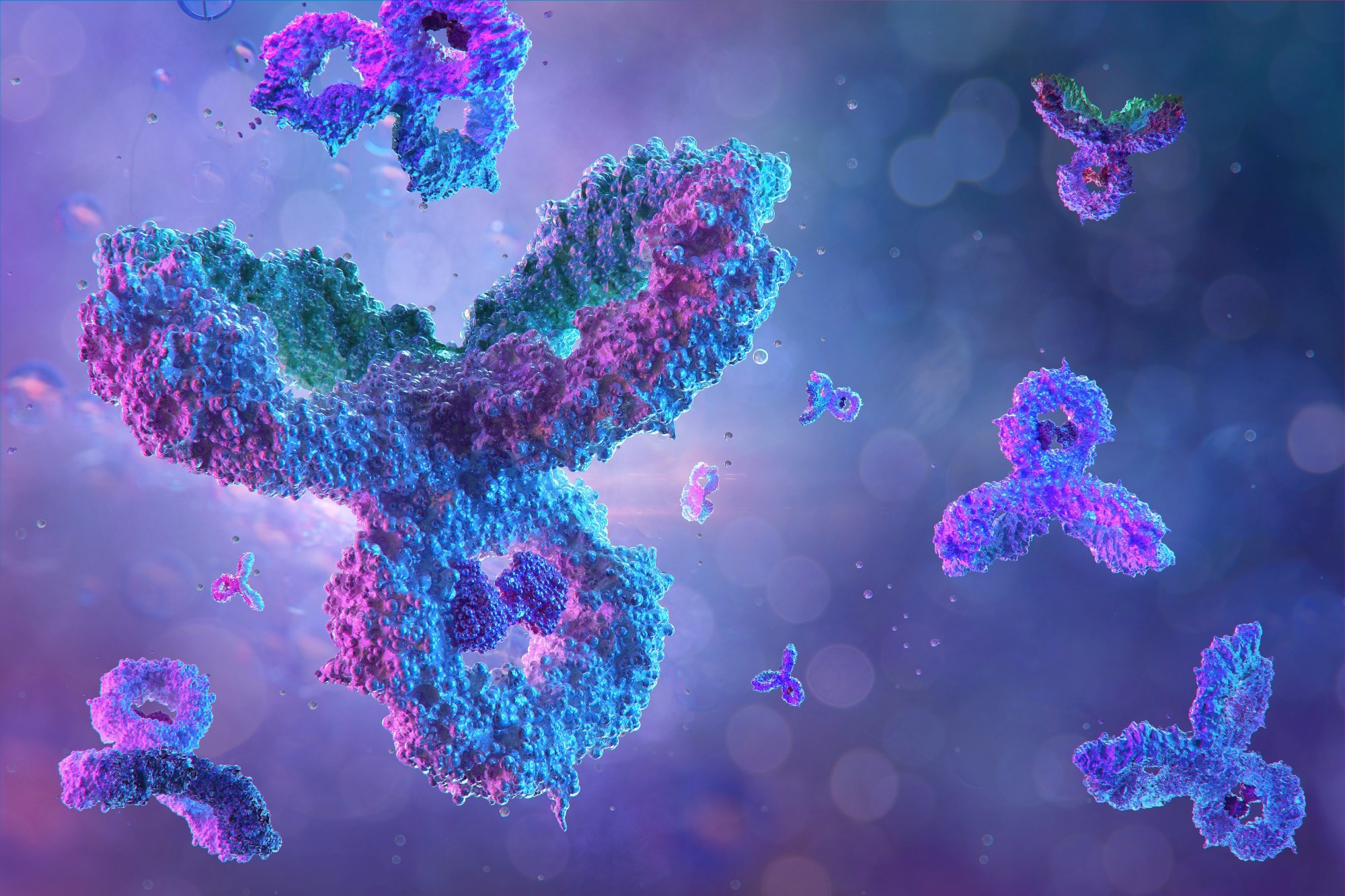In a recent study published in the Science Advances Journal, a group of researchers developed potent monoclonal antibodies from a severe acute respiratory syndrome coronavirus (SARS-CoV) survivor vaccinated with BNT162b2 that targets the receptor binding domain (RBD) of human angiotensin-converting enzyme 2 (huACE2)-dependent sarbecovirus.
 Study: Potent pan huACE2-dependent sarbecovirus neutralizing monoclonal antibodies isolated from a BNT162b2-vaccinated SARS survivor. Image Credit: Corona Borealis Studio/Shutterstock.com
Study: Potent pan huACE2-dependent sarbecovirus neutralizing monoclonal antibodies isolated from a BNT162b2-vaccinated SARS survivor. Image Credit: Corona Borealis Studio/Shutterstock.com
Background
Over the last 20 years, three significant outbreaks have occurred due to zoonotic coronaviruses: SARS-CoV, Middle East respiratory syndrome (MERS-CoV), and the ongoing SARS-CoV-2 pandemic.
These viruses, including emerging variants, originated from animals like bats and pangolins. Neutralizing antibodies (NAbs), formed through natural infection or vaccination, play crucial roles in combating these infections. However, the emergence of variants of concern (VOCs) challenges this defense.
Consequently, therapeutic monoclonal antibodies (mAbs), developed rapidly as a part of the global response to COVID-19, have been crucial. Nevertheless, the evolving VOCs have reduced the effectiveness of current mAbs, necessitating the development of new ones effective against various sarbecoviruses.
About the study
The present study included a 51-year-old SARS survivor vaccinated with BNT162b2 in early 2021. After the patient's plasma was collected, the peripheral blood mononuclear cells (PBMCs) were extracted and cryopreserved.
These cells were later stained for SARS-CoV RBD (SC1) and SARS-CoV-2 RBD (SC2) tetramers. B cells were sorted and then flash-frozen for future use.
Reverse transcription and nested polymerase chain reaction (PCR) were performed on the sorted B cells. Specific primers were used to amplify individual gene families, and the PCR products were cloned into the pTRIOZ expression vector.
These constructs were then transfected into the human embryonic kidney (HEK) 293 cells, and the supernatant was tested using an enzyme-linked immunosorbent assay (ELISA) and surrogate Virus Neutralization Test (sVNT).
Serum samples were tested using a newly developed multiplex sVNT (m-sVNT) assay. The antibodies' concentrations were diluted and then incubated with recombinant huACE2. SARS-CoV-2 RBD mutants were purified and coupled onto magnetic multiplex beads.
A single-point mutation yeast display library of SARS-CoV-2 RBD was constructed and used to determine the effect of each mutation on binding or expression.
The binding affinities of the antibodies to SARS-CoV or SARS-CoV-2 RBD protein were measured by bio-layer interferometry using an Octet RED96e. Pseudoviruses were produced and used to test the mAbs' neutralization ability.
The plaque reduction neutralization test (PRNT) was used to assess further the antibodies' ability to neutralize SARS-CoV-2 (ancestral or Omicron BA.1 and BA.2 strains).
The cytotoxic effects of the antibodies on Vero E6 transmembrane protease, serine 2 (TMPRSS2) cells were assessed by the CellTiter-Glo luminescent cell viability assay.
The cryogenic electron microscopy (Cryo-EM) image processing incorporated nine optics groups based on beam image shift values for processing in RELION.
It involved movie frame alignment, determination of contrast transfer function parameters, particle picking, and extraction. 2D classification is followed by manual selection and extraction of good classes. The process led to the generation of initial 3D models and the selection of good models.
Study results
The results of the present study revealed that the SARS survivor vaccinated with BNT162b2 produced broad NAbs effective against ten huACE2-dependent sarbecoviruses from Clade-1a and Clade-1b, which includes several variants of SARS-CoV-2 and animal sarbecoviruses.
B cell enrichment and isolation were performed by utilizing the donor's PBMCs 23 days post-first dose of BNT162b2.
Upon sorting cluster of differentiation 19 (CD19+) B cells binding to SARS-CoV and SARS-CoV-2 RBD tetramers, their antibody genes were amplified, cloned, and expressed in vitro, yielding 19 paired heavy and light kappa fragments.
The majority were from double-positive B cells, with two originating from SC2+ B cells and none from SC1+ single-positive B cells.
In addition to the newly discovered mAbs, the researchers included five published mAbs for comparison. Although mAbs from SC2+ single-positive B cells exhibited minimal reactivity to SARS-CoV RBD, those from SC1+SC2+ B cells displayed varied neutralization capabilities.
The six most potent neutralizing mAbs were selected for further characterization and large-scale production. Interestingly, three employed a unique combination of heavy- and light-chain gene families not previously reported.
Next, an 18-plex sVNT was performed to measure the breadth and functionality of the mAbs. The results revealed that mAbs exhibited a potent ability to neutralize all 18 sarbecoviruses tested, suggesting their broad-spectrum neutralizing activity.
The study also investigated the effect of individual RBD amino acid mutations on the binding of mAbs and mapped the epitope footprint of each mAb on RBD. The mAbs demonstrated markedly different epitope profiles. It was found that most mAbs have epitopes comprising key residues within a restricted region, indicating their broad neutralizing potency.
On determining the mAbs' affinity to RBDs of SARS-CoV-2 mutants, it was found that the most potent mAbs bound strongly to all RBD mutants, while CR3022 mAb displayed the lowest binding affinity to all the SARS-CoV-2 RBD mutants.
Despite moderate to good binding activity, some mAbs demonstrated poor performance in the RBD-ACE2 inhibition assay, suggesting that binding ability does not always equate to neutralizing ability.
Lastly, the E7 fragment antigen-binding (Fab) fragment structure complexed with recombinant SARS-CoV-2 spike protein trimer was determined using single-particle cryo-EM.
It was revealed that E7 binds to a quaternary epitope across an "up" RBD and a neighboring "down" RBD, most of its interaction being on the up RBD.
Researchers further reported that mAbs E7 and F5 showed potent activity against Omicron subvariants BA.1 and BA.2. However, only E7 maintained neutralizing potency against BA.2 in the authentic virus neutralization tests.
Even newer Omicron subvariants, including BQ.1.1 and XBB.1, were susceptible to E7, indicating that these strains were still sensitive to this monoclonal antibody despite acquiring more mutations.